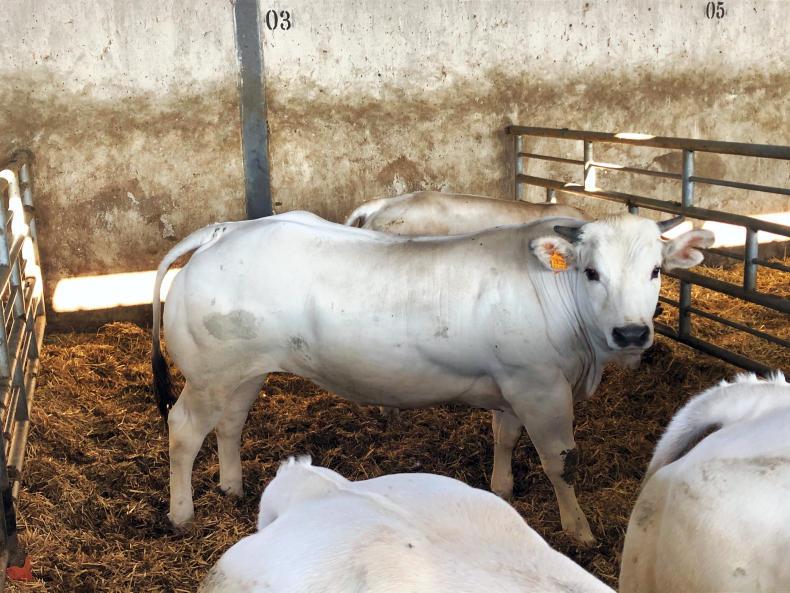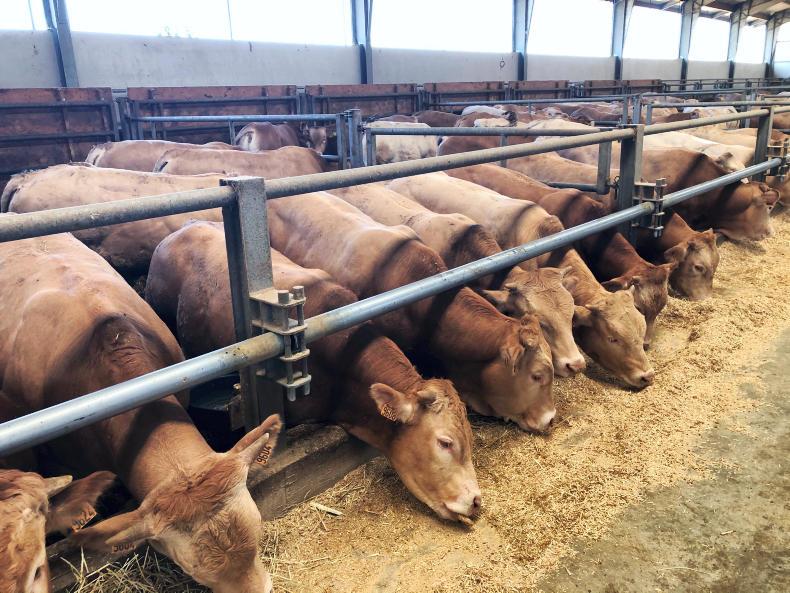Last Monday night, the Teagasc/Irish Farmers Journal BETTER farm beef challenge landed in Milan and headed two hours south-east towards Turin, in the Piedmont region of Italy. The trip was organised in conjunction with the LIFE Beef Carbon project, a joint beef carbon emissions reduction project between Ireland, Spain, France and Italy.
Each of these countries has a collection of monitor farms and Ireland’s representation comes in the form of the BETTER farm beef challenge participants, among others. Here are just some of the highlights from the trip.
Rubiolo Gugini;
Racconigi, Piedmont –
Beef finishing farm
The Gugini farm and feedlot, located just outside the town of Racconigi, puts 500-head of cattle through its gates each year. It would be fair to say that the main enterprise on the 150ha farm is tillage, with the main use of the maize and corn grown being to feed the farm’s biogas plant, a pretty common scenario across much of central Europe. In addition, some corn is sold for milling and a smaller portion is stored on the farm as cattle feed.
It’s bulls all the way in this feedlot.

Cattle on the farm of Rubiolo Gugini, Racconigi, Piedmont, Italy.
The sole breeds purchased are Limousin and Blonde d’Aquitaine and unsurprisingly, they are all purebred. All of the cattle in the feedlot come from France. They arrive at 300kg to 350kg liveweight at around eight months of age. Landed in the yard, the current purchase price is €3/kg. They are vaccinated for IBR before leaving France.
Animals are held in the feedlot for six to eight months. They need to be held for at least six months to avail of a €60/head slaughter premium. During the animal’s residency, it will transition between three diets: a one-month starter diet, a transitional diet and a fattening diet. Details of the fattening diet are given in Table 1. Daily allocation is 14kg fresh weight/head/day on average, with an approximate cost of €2/head/day. Corn straw and maize thrash is used as bedding.
Slaughter price was quoted in liveweight. Limousin bulls are currently making €2.80/kg liveweight, while Blonde’s are being sold at €3/kg. Target liveweight at slaughter is 750kg and there is no age limit.
AZ Moderna;
Fossano, Piedmont –
Suckler to beef farm
AZ Moderna is a company farm owned by two cousins. It comprises 240ha, growing predominantly maize, corn and grass. The grass is not a typical ryegrass, but rather a tri-annual, multispecies sward, consisting of a high percentage of legumes. It’s not grazed either, as hay making is the preferred option, as it is less labour intensive to keep the herd indoors and bring in the grass/hay and none of the grassland is permanent.

Piedmontese cow and calf on the AZ Moderna farm, Fossano, Piedmont.
Indoors, the farm keeps 95 Piedmontese suckler cows. In a somewhat uncommon system, all male progeny are castrated at around 30 days of age. The reason for this is because the farm is part of a consortium to produce high quality beef, and the steers can offer a similar texture and quality to heifer beef.
One hundred percent AI is used, with bulls chosen based on progeny performance and their ability to breed highly functional replacements.

Piedmontese calf on the AZ Moderna farm, Fossano, Piedmont.
Calving takes place all year round and the average number of calving’s per cow is seven. Calves are weaned at four to five months of age and maiden heifers are calved at two months of age.
My initial reaction was that calves are excellent quality at birth, but performance is severely affected by a lack of milk.
Steers are slaughtered at 16 months, at a target liveweight of 550kg or 380kg dead. Surplus heifers are slaughtered at 15 months, with a target liveweight set at 480kg or 320kg dead. In what is a very specialised system, the farmer receives €7.30/kg of carcase. All suckler farms in the Piedmont region receive a €124 subsidy per calf born.
Sergio and Ivano Giordano; Fossano, Piedmont –
Beef finishing farm
The Giordano farm in Fossano puts 1,400 to 1,500 head of cattle through its gates each year, all of them bulls.
The 90ha farm is spread across four sites, which in total grow 70ha of corn and 10ha of maize silage.

Blonde d'Aquitanes on Sergio and Ivano Giordano's farm in Fossano, Piedmont.
Weanlings, mainly purebred Blonde d’Aquitaine, arrive from France at 380kg to 400kg. Per head, they are dropped in the yard at €1,300.
Bulls are held for 200 to 220 days. They must be kept for at least six months to qualify for a €60/head subsidy. The estimated cost of production on the farm is €2.60/head/day, which spread over 210 days amounts to €546/head.

Blonde d'Aquitanes on Sergio and Ivano Giordano's farm in Fossano, Piedmont.
Bulls are slaughtered between 700kg and 750kg liveweight – 730kg is the average. Cattle are required by the processor to achieve a 66% kill-out. Quoted in liveweight, the selling price is currently €3.05/kg.
Last Monday night, the Teagasc/Irish Farmers Journal BETTER farm beef challenge landed in Milan and headed two hours south-east towards Turin, in the Piedmont region of Italy. The trip was organised in conjunction with the LIFE Beef Carbon project, a joint beef carbon emissions reduction project between Ireland, Spain, France and Italy.
Each of these countries has a collection of monitor farms and Ireland’s representation comes in the form of the BETTER farm beef challenge participants, among others. Here are just some of the highlights from the trip.
Rubiolo Gugini;
Racconigi, Piedmont –
Beef finishing farm
The Gugini farm and feedlot, located just outside the town of Racconigi, puts 500-head of cattle through its gates each year. It would be fair to say that the main enterprise on the 150ha farm is tillage, with the main use of the maize and corn grown being to feed the farm’s biogas plant, a pretty common scenario across much of central Europe. In addition, some corn is sold for milling and a smaller portion is stored on the farm as cattle feed.
It’s bulls all the way in this feedlot.

Cattle on the farm of Rubiolo Gugini, Racconigi, Piedmont, Italy.
The sole breeds purchased are Limousin and Blonde d’Aquitaine and unsurprisingly, they are all purebred. All of the cattle in the feedlot come from France. They arrive at 300kg to 350kg liveweight at around eight months of age. Landed in the yard, the current purchase price is €3/kg. They are vaccinated for IBR before leaving France.
Animals are held in the feedlot for six to eight months. They need to be held for at least six months to avail of a €60/head slaughter premium. During the animal’s residency, it will transition between three diets: a one-month starter diet, a transitional diet and a fattening diet. Details of the fattening diet are given in Table 1. Daily allocation is 14kg fresh weight/head/day on average, with an approximate cost of €2/head/day. Corn straw and maize thrash is used as bedding.
Slaughter price was quoted in liveweight. Limousin bulls are currently making €2.80/kg liveweight, while Blonde’s are being sold at €3/kg. Target liveweight at slaughter is 750kg and there is no age limit.
AZ Moderna;
Fossano, Piedmont –
Suckler to beef farm
AZ Moderna is a company farm owned by two cousins. It comprises 240ha, growing predominantly maize, corn and grass. The grass is not a typical ryegrass, but rather a tri-annual, multispecies sward, consisting of a high percentage of legumes. It’s not grazed either, as hay making is the preferred option, as it is less labour intensive to keep the herd indoors and bring in the grass/hay and none of the grassland is permanent.

Piedmontese cow and calf on the AZ Moderna farm, Fossano, Piedmont.
Indoors, the farm keeps 95 Piedmontese suckler cows. In a somewhat uncommon system, all male progeny are castrated at around 30 days of age. The reason for this is because the farm is part of a consortium to produce high quality beef, and the steers can offer a similar texture and quality to heifer beef.
One hundred percent AI is used, with bulls chosen based on progeny performance and their ability to breed highly functional replacements.

Piedmontese calf on the AZ Moderna farm, Fossano, Piedmont.
Calving takes place all year round and the average number of calving’s per cow is seven. Calves are weaned at four to five months of age and maiden heifers are calved at two months of age.
My initial reaction was that calves are excellent quality at birth, but performance is severely affected by a lack of milk.
Steers are slaughtered at 16 months, at a target liveweight of 550kg or 380kg dead. Surplus heifers are slaughtered at 15 months, with a target liveweight set at 480kg or 320kg dead. In what is a very specialised system, the farmer receives €7.30/kg of carcase. All suckler farms in the Piedmont region receive a €124 subsidy per calf born.
Sergio and Ivano Giordano; Fossano, Piedmont –
Beef finishing farm
The Giordano farm in Fossano puts 1,400 to 1,500 head of cattle through its gates each year, all of them bulls.
The 90ha farm is spread across four sites, which in total grow 70ha of corn and 10ha of maize silage.

Blonde d'Aquitanes on Sergio and Ivano Giordano's farm in Fossano, Piedmont.
Weanlings, mainly purebred Blonde d’Aquitaine, arrive from France at 380kg to 400kg. Per head, they are dropped in the yard at €1,300.
Bulls are held for 200 to 220 days. They must be kept for at least six months to qualify for a €60/head subsidy. The estimated cost of production on the farm is €2.60/head/day, which spread over 210 days amounts to €546/head.

Blonde d'Aquitanes on Sergio and Ivano Giordano's farm in Fossano, Piedmont.
Bulls are slaughtered between 700kg and 750kg liveweight – 730kg is the average. Cattle are required by the processor to achieve a 66% kill-out. Quoted in liveweight, the selling price is currently €3.05/kg.











 This is a subscriber-only article
This is a subscriber-only article










SHARING OPTIONS: